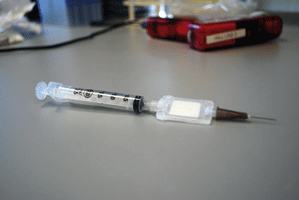
Vaccine delivery breakthrough

New system offers cheap wayy to make vaccines stable
(Photo: Oxford University)
Infectious diseases kill millions of people every year and children under the age of five, especially those in developing countries, are particularly vulnerable. While significant progress has been made through global immunization campaigns to protect against many of these diseases, the delivery of vaccines to target populations is costly and requires considerable logistical support.
All vaccines currently recommended by the World Health Organization (WHO) to treat these diseases – DTP (diphtheria, tetanus, pertussis (whooping cough)), BCG (tuberculosis), oral polio vaccine (poliomyelitis), yellow fever (for countries at risk) and measles - require cold storage (between 2ºC and 8ºC) to remain stable and viable. This can significantly increase the cost per dose of these vaccines and can result in significant vaccine wastage arising from breaks in the cold chain. Equally, if not more importantly, it leads to a significant proportion of ineffective vaccines being administered with consequent loss of life. Some estimate that up to 40% or more of vaccines are ineffective in sub-Saharan Africa.
Last year, British scientists made a breakthrough that “offers a simple and cheap way of making vaccines stable – even at tropical temperatures”, using a technology that promises to “revolutionize vaccination efforts”.
In early 2010, scientists from the Jenner Institute, University of Oxford and from the British company Nova Bio-Pharma Technologies, carried out a proof-of-concept study1 showing that vaccines they are developing can be stabilized for months using Nova’s patented Hypodermic Rehydration Injection System (HydRIS).
“Currently vaccines need to be stored in a fridge or freezer. That means that you need a clinic with a nurse, a fridge and an electricity supply, and refrigeration lorries for distribution,” explains Dr. Matt Cottingham of the Jenner Institute at the University of Oxford, lead author of the study. “If you could ship vaccines at normal temperatures, you would greatly reduce cost and hugely improve access to vaccines,” he says. “You could even picture someone with a backpack taking vaccine doses on a bike into remote villages.”
The team demonstrated that two different virus-based vaccines could be stored on sugar-stabilized membranes for 6 months at 45ºC without any deterioration. When stored at 37ºC for 12 months, these vaccines showed only very small losses in the amount of viral vaccine re-obtained from the membrane.
“We’ve shown that a very simple way of heat-stabilizing vaccines works for two viruses that are being used as the basis for novel vaccines in development,” Professor Adrian Hill of Oxford University observed. “This is very exciting scientifically, because these viruses are fragile. If we are able to stabilize these, other vaccines are likely to be easier.”
The vaccines use live viruses that have been engineered so that when they enter the body they stimulate an effective immune response without replicating and causing infection. A long shelf life for live-virus-based vaccines is therefore desirable when delivering these vaccines to patients in remote areas.
Using this method, vaccines are mixed with the sugars trehalose2 and sucrose. This mixture is left to dry slowly on a filter or membrane where it eventually solidifies to form a thin sugary film. This preserves the active part of the vaccine “in a kind of suspended animation” and protects it against deterioration even at high temperatures. By flushing the membrane with water, the vaccine is instantly rehydrated. “The beauty of this approach is that a simple plastic cartridge, containing the membrane with vaccine dried on, can be placed on the end of a syringe,” explains Dr. Cottingham. “Pushing a water solution from the syringe over the membrane would then release the vaccine and inject it into the patient.”

Dr. Matt Cottingham, lead author of the
study (Photo: Oxford University)
For Nova’s Managing Director, Peter White, “this new technique of drug delivery is one of the most exciting developments in the British pharmaceutical and biotechnology industries, especially as it can be used for highly unstable products, for instance vaccines for malaria.”
Preparing vaccines that do not require refrigeration has been identified as one of the major unsolved problems of global health. Maintaining the cold chain for vaccines costs millions of dollars a year. In 2000, the total annual expenditure on immunization for low-income countries averaged US$6 per live birth. By 2010, the cost of immunization with traditional vaccines as well as hepatitis B and Hib (haemophilus influenza type b3) vaccines reached US$18 per live birth according to the WHO.
Dr. Michel Zaffran, Director of Project Optimize, a WHO partnership with the US-based Program for Appropriate Technology in Health said, “the development is going in the right direction. If the process was to be applied to new vaccines that would be great.”
Oxford University and Nova Laboratories have submitted a patent application in relation to the stabilization of vaccines based on viruses. Patents have already been granted on the HydRIS delivery device – described as a pharmaceutical device for the administration of substrates to patients – in most EU countries. Isis Innovation, Oxford University’s technology transfer company is currently working with the research team to put a commercial strategy in place for the development of the technology.
| Isis Innovation |
|---|
| Isis Innovation, Oxford University’s technology transfer company, manages the University’s intellectual property portfolio. It works with University researchers to identify, protect and market technologies through licensing, through the establishment of spin-off companies and through sales. On average, Isis Innovation files one new patent application each week. It has concluded 400 technology licensing agreements and established 64 spin-off companies. Isis also manages Oxford University Consulting which offers services to clients seeking to enhance innovative capability, by giving them access to the world-class expertise of the University’s academics. A separate business division, Isis Enterprise, offers consulting expertise and advice in technology transfer and open innovation to a global client base including universities, governments and industry. Established in 1987, Isis Innovation is one of the world’s leading technology transfer and innovation management companies – www.isis-innovation.com |
The next step for the researchers is to validate the usefulness of the technology for other vaccines and medicinal products that place a burden on the cold chain, or that are proving difficult or too expensive to be formulated by other means such as freeze drying (lyophilization). “There is confidence that the technology can be adapted to work with various products,” said Dr. Migena Bregu, spokesperson for the project.
Emphasis is also now being placed on developing good manufacturing practice (GMP)4 guidelines for manufacturing the multi-component vaccine-membrane-device suitable for human use; demonstrating that the technology is suitable and safe for human use and offers a superior solution to conventional means of administering vaccines; and scaling-up the technology so that it can be produced cost-effectively. Cost is a key issue for the deployment of this technology in the longer term. As noted by Dr. Zaffran, “the catch 22 is that because many vaccines continue to be used that require a cold chain, there is little incentive for countries to purchase a heat-stable vaccine if it is more expensive than a non-heat-stable formulation of an equivalent vaccine.”
The Jenner Institute’s expertise in vaccine development and clinical testing combined with Nova’s expertise in sugar-based formulations and drug manufacturing, Dr. Bregu said, “gives us confidence that we are on a fast and well integrated path for the progression of the technology to reach human use within the next two to five years.”
While this promising technology brings us one step closer to developing vaccines that do not require refrigeration, many challenges lie ahead. One of those relates to what Dr. Zaffran refers to as the “cold-chain dogma” which has emerged in the past 30 years – the perception that all vaccines require cold storage. In fact, at least 15 vaccines that are transported and stored between 2ºC and 8ºC could withstand temperatures of up to 40ºC. These include vaccines to prevent rotavirus, cholera and typhoid infections.
__________________________
1 This research was funded by the Grand Challenges in Global Health partnership of the Bill & Melinda Gates Foundation, with additional financial support from the Wellcome Trust.
2 Trehalose – is a sugar associated with the ability of plants and animals to withstand prolonged periods of extreme dryness. When rehydration occurs, its properties enable normal cellular activity to resume without the major, lethal damage that would normally follow a dehydration/rehydration cycle.
3 Most strains of H. influenzae are opportunistic pathogens. They usually live in their host without causing disease, but cause problems only when other factors (such as a viral infection or reduced immune function) create an opportunity. In infants and young children, H. influenzae type b (Hib) causes bacteremia, pneumonia and acute bacterial meningitis.
4 GMP –is part of a quality system covering the manufacture and testing of active pharmaceutical ingredients. GMP guidelines which consist of a series of general principles that must be observed during drug manufacture, outline the aspects of production and testing that can impact the quality of a product.
The WIPO Magazine is intended to help broaden public understanding of intellectual property and of WIPO’s work, and is not an official document of WIPO. The designations employed and the presentation of material throughout this publication do not imply the expression of any opinion whatsoever on the part of WIPO concerning the legal status of any country, territory or area or of its authorities, or concerning the delimitation of its frontiers or boundaries. This publication is not intended to reflect the views of the Member States or the WIPO Secretariat. The mention of specific companies or products of manufacturers does not imply that they are endorsed or recommended by WIPO in preference to others of a similar nature that are not mentioned.